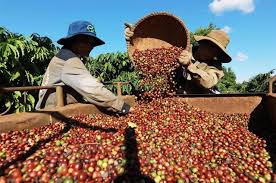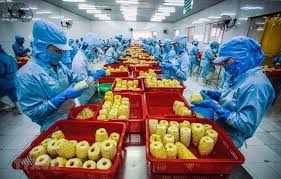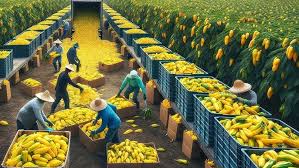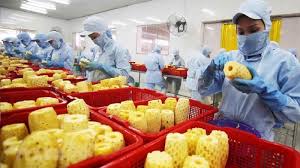Agricultural product processing refers to transforming raw agricultural materials like grains, fruits, vegetables, and animal products into forms that are more suitable for consumption, storage, or marketing. Processing not only adds value to agricultural products but also extends their shelf life, ensures safety, and improves their marketability.
Agricultural processing can range from simple methods like drying and cleaning to more complex procedures such as fermentation, packaging, and canning.
Importance of Processing in Agriculture
Processing plays a crucial role in the agricultural sector for several reasons:
1. Value Addition: Processing converts raw materials into higher-value products. For example, turning wheat into flour or milk into cheese adds value and increases profitability.
2. Preservation: Processing extends the shelf life of perishable products by preventing spoilage. Techniques like drying, freezing, and canning help preserve food for longer periods.
3. Food Safety: Proper processing removes harmful pathogens, toxins, and contaminants, ensuring food safety for consumers. Pasteurization of milk, for instance, kills harmful bacteria.
4. Market Expansion: Processed products are often easier to transport and sell in distant markets, expanding the reach of agricultural products.
5. Reducing Waste: Processing helps utilize by-products or less desirable parts of raw materials that might otherwise go to waste. For example, corn husks can be used for animal feed after processing.
Primary Processing Techniques

Primary processing involves the initial handling of raw agricultural products to make them safe and suitable for consumption or further processing. It usually focuses on basic transformation without altering the fundamental nature of the product.
1. Cleaning: Removing impurities such as dirt, stones, and debris from harvested crops is essential before any further processing. For instance, cleaning grains like rice or wheat ensures better quality.
2. Drying: Drying reduces the moisture content of crops like grains, fruits, and vegetables, which helps prevent spoilage and makes them easier to store. Sun drying and mechanical drying are common methods.
3. Milling: Milling involves grinding grains such as wheat, corn, and rice into flour or meal. This process makes the grains more suitable for consumption or secondary processing.
4. Shelling and Husking: For crops like nuts, grains, and legumes, primary processing may involve removing the outer shells or husks. Examples include dehusking rice or shelling peanuts.
5. Sorting and Grading: Sorting and grading ensure that agricultural products meet quality standards. For example, fruits and vegetables are often sorted based on size, color, or ripeness.
Secondary Processing Methods
Secondary processing involves transforming primary processed products into more refined forms that are ready for consumption or sale. This stage includes more complex processes, such as cooking, fermenting, or combining ingredients.
1. Canning: Canning involves sealing food in airtight containers and heating them to kill bacteria, ensuring long-term preservation. Vegetables, fruits, and meats are often canned for extended storage.
2. Freezing: Freezing is one of the most effective methods for preserving perishable foods like meat, fruits, and vegetables. It slows down the decomposition process and extends the shelf life of products.
3. Fermentation: This method involves using microorganisms like yeast or bacteria to convert sugars into acids, gases, or alcohol. Fermented products like yogurt, cheese, and pickles have longer shelf lives and distinctive flavors.
4. Baking and Cooking: Some agricultural products, such as wheat or potatoes, undergo baking or cooking to be made into ready-to-eat products like bread or chips.
5. Pasteurization: Pasteurization heats liquid products, like milk and fruit juices, to a specific temperature to kill harmful bacteria while preserving the nutritional quality of the food.
Read Also: Nutritional Profile and Introduction to Food Rating System Chart of Cashew
Traditional vs. Modern Processing Techniques

Agricultural product processing has evolved over time, with both traditional and modern techniques being widely used today. Each method has its advantages and limitations.
1. Traditional Processing Techniques:
i. Manual Labor: Traditional processing methods often rely on manual labor, such as hand-pounding grains or sun-drying crops. These methods are low-cost but time-consuming.
ii. Natural Methods: Many traditional methods use natural elements like the sun, wind, or fire to process food. For example, sun-drying is a common traditional method for preserving fruits and vegetables.
iii. Small Scale: Traditional processing is often done on a smaller scale, typically for local consumption. This is common in subsistence farming communities.
2. Modern Processing Techniques:
i. Mechanization: Modern processing techniques use advanced machinery to process large quantities of products efficiently. Automated systems can clean, sort, and package products at a faster rate than manual methods.
ii. Technological Innovation: Modern techniques involve sophisticated technology like cold storage, pasteurization, and fermentation control. These innovations increase efficiency and ensure higher food safety standards.
iii. Larger Scale: Modern processing is often done on a large, industrial scale to meet the demands of mass markets, including national and international trade.
Processing Techniques for Specific Agricultural Products
Different agricultural products require specific processing techniques to preserve their quality, enhance their market value, and make them suitable for consumption or further use. Here’s a look at some common agricultural products and the corresponding processing techniques.
1. Grains (Wheat, Rice, Corn): Grains are often processed through cleaning, milling, and drying.
i. Milling: Grains like wheat and corn are ground into flour or meal for consumption or further processing.
ii. Drying: This reduces moisture, ensuring a longer shelf life.
iii. Polishing and Parboiling (for rice): These methods remove the outer layers of rice to improve texture and flavor.
2. Fruits and Vegetables: Fruits and vegetables are perishable and require quick, effective processing to retain freshness.
i. Juicing and Canning: Fruits like oranges and tomatoes are often processed into juices or canned for longer storage.
ii. Freezing: Vegetables such as peas and spinach are commonly frozen to retain nutrients and extend their shelf life.
iii. Dehydration: Drying fruits like apples and bananas reduces their water content, making them lighter and more durable for storage.
3. Dairy Products (Milk, Cheese, Yogurt):
i. Pasteurization: Heating milk to eliminate harmful bacteria without losing its nutritional value.
ii. Fermentation: Dairy products like yogurt and cheese undergo fermentation using specific bacteria to produce distinct textures and flavors.
iii. Homogenization: This technique ensures a uniform distribution of fat in milk, making it smooth and preventing separation.
4. Meat and Poultry: Meat processing involves handling, preservation, and packaging.
i. Slaughtering and Butchering: After slaughter, the meat is cut into various parts for consumption.
ii. Curing and Smoking: Meats like ham and bacon are preserved through curing (using salt) and smoking to improve flavor and shelf life.
iii. Freezing: Meat is often frozen to prevent spoilage.
5. Nuts and Seeds:
i. Roasting: Nuts like almonds and peanuts are roasted to enhance flavor.
ii. Shelling: Shelling machines remove the outer husks of nuts and seeds.
iii. Oil Extraction: Some seeds, such as sunflower and sesame, undergo oil extraction through pressing or chemical processes.
Key Factors Affecting Processing Techniques
Several factors influence the choice of processing techniques for agricultural products. Understanding these factors can help processors select the best methods to ensure product quality and efficiency.
1. Type of Product: Different products have unique characteristics that affect their processing. For example, grains require drying, while dairy products need pasteurization.
2. Shelf Life: Highly perishable products like fruits and vegetables need quick processing methods like freezing or canning to extend their shelf life. In contrast, grains can be stored for longer periods with basic cleaning and drying.
3. Nutritional Value: Preserving the nutritional quality of the product is crucial. For instance, gentle drying methods or freezing can retain the nutrients in vegetables, while overcooking can destroy essential vitamins.
4. Market Demand: Processing techniques can vary based on consumer preferences. For example, some markets prefer whole grains, while others may demand processed or refined flour.
5. Technological Availability: The availability of advanced machinery and technology plays a significant role in the processing method chosen. In rural areas with limited infrastructure, traditional methods like sun drying may be more common.
6. Cost: The cost of processing equipment, labor, and energy also determines the techniques used. Modern methods such as freeze-drying can be expensive, while traditional sun drying may be more affordable but time-consuming.
Read Also: How to Select, Store and Enjoy Cashew
Innovations in Agricultural Product Processing

Agricultural processing has evolved with innovations aimed at increasing efficiency, improving quality, and ensuring sustainability. Some of the latest innovations include:
1. Freeze-Drying Technology: This method involves freezing the product and then removing the moisture in a vacuum. It retains most of the nutritional content and is widely used for fruits, vegetables, and coffee.
2. High-Pressure Processing (HPP): HPP uses high pressure to eliminate pathogens without heat, preserving the freshness and taste of products like fruit juices and meat. This technique is gaining popularity as a safer and more natural alternative to heat pasteurization.
3. Smart Packaging: Advances in packaging materials, such as biodegradable and smart packaging, help extend shelf life while reducing environmental impact. Smart packaging can monitor the freshness of products and notify consumers of spoilage.
4. Automated Sorting and Grading: Automated systems use sensors and artificial intelligence to sort agricultural products based on size, quality, and ripeness. This innovation reduces manual labor and improves efficiency in processing facilities.
5. Cold Chain Management: Maintaining an uninterrupted cold chain ensures that perishable products remain fresh from farm to consumer. Innovations in cold storage and transportation have significantly improved food safety and reduced post-harvest losses.
6. Nanotechnology in Food Processing: Nanotechnology is being used to improve food preservation, enhance nutritional content, and develop new packaging materials. It offers promising solutions for extending the shelf life of processed products.
Challenges in Agricultural Processing
Despite advancements, agricultural processing faces several challenges that hinder its full potential.
1. Limited Access to Technology: In many developing regions, access to advanced processing technologies is limited due to high costs or lack of infrastructure. This results in reliance on traditional, less efficient methods, which can affect product quality.
2. High Energy Consumption: Some modern processing methods, like freezing and canning, require large amounts of energy. This poses a challenge in areas where electricity is expensive or unreliable.
3. Food Safety Concerns: Ensuring food safety during processing is a major challenge. Contamination can occur at any stage, from handling to packaging. Strict quality control measures are necessary to prevent foodborne illnesses.
4. Environmental Impact: Processing techniques that rely heavily on chemicals, plastics, or energy can contribute to environmental degradation. There is a growing need for more sustainable processing methods that minimize waste and reduce carbon footprints.
5. Lack of Skilled Labor: The efficiency of modern processing methods often depends on skilled labor to operate machinery and handle complex procedures. In many areas, there is a shortage of trained workers, which can slow down processing operations.
6. Post-Harvest Losses: A significant portion of agricultural products is lost after harvest due to improper handling, storage, or transportation. Improving processing and storage techniques is essential to reduce these losses and ensure food security.
Agricultural product processing is vital to the agricultural industry as it adds value to raw products, ensures food safety, and increases market opportunities. Primary processing techniques like cleaning and drying prepare raw materials for consumption, while secondary processing methods such as canning and freezing extend their shelf life and improve their quality.
While traditional methods are still widely used, modern techniques offer greater efficiency and broader market potential. Understanding both approaches helps farmers and processors choose the best methods for their agricultural products, ensuring a balance between productivity, safety, and sustainability.
Do you have any questions, suggestions, or contributions? If so, please feel free to use the comment box below to share your thoughts. We also encourage you to kindly share this information with others who might benefit from it. Since we can’t reach everyone at once, we truly appreciate your help in spreading the word. Thank you so much for your support and for sharing!
Read Also: Sources and Classification of Hazardous Waste
Frequently Asked Questions
We will update this section soon.

